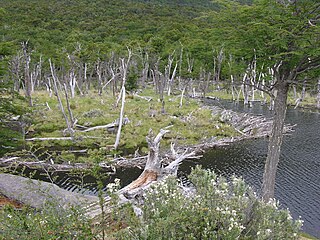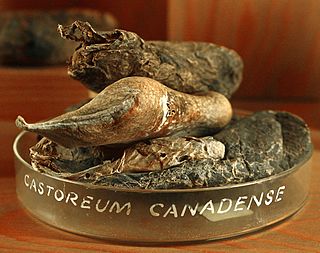 W
WBeavers are large, semiaquatic rodents of the temperate Northern Hemisphere. There are two extant species in the genus Castor, the North American beaver and the Eurasian beaver. Beavers are the second largest living rodents after the capybaras. They have stout bodies with large heads, long chisel-like incisors, brown or gray fur, hand-like front feet, webbed back feet and flat, scaly tails. The animals can be found in a number of freshwater habitats, such as rivers, streams, lakes and ponds. They are herbivorous and consume tree bark, aquatic plants, brush, grasses and sedges.
 W
WA beaver attack is an attack on a human or domestic pet by a beaver. Beaver attacks are relatively uncommon but are becoming more frequently reported, as it is more common for humans to enter and disturb the natural habitat of these animals.
 W
WBeaver dams or beaver impoundments are dams built by beavers to provide ponds as protection against predators such as coyotes, wolves, and bears, and to provide easy access to food during winter. These buildings modify the natural environment in such a way that the overall ecosystem builds upon the change, making beavers a keystone species. Beavers work at night and are prolific builders, carrying mud and stones with their fore-paws and timber between their teeth.
 W
WThe eradication of the North American beaver in Tierra del Fuego is being attempted by the governments of Chile and Argentina in this area at the southernmost tip of South America. The non-native species was introduced in 1946 as a potential source of commercial fur trading. When the fur trade industry was unsuccessful, however, the beavers became problematic and the governments agreed to intervene. A June 2011 NPR report stated that the beavers have caused millions of dollars in damages. According to Nature, this plan is the largest eradication project ever attempted.
 W
WA beaver hat is a hat made from felted beaver fur. They were fashionable across much of Europe during the period 1550–1850 because the soft yet resilient material could be easily combed to make a variety of hat shapes. Smaller hats made of beaver were sometimes called beaverkins, as in Thomas Carlyle's description of his wife as a child.
 W
WBeaver Pipes are a non-destructive flow devices, a way of controlling beaver activity in an ecosystem. The process of building beaver pipes is quite simple, and often serves as a permanent way to prevent beavers from damming water.
 W
WBeavers are large, semiaquatic rodents of the temperate Northern Hemisphere. There are two extant species in the genus Castor, the North American beaver and the Eurasian beaver. Beavers are the second largest living rodents after the capybaras. They have stout bodies with large heads, long chisel-like incisors, brown or gray fur, hand-like front feet, webbed back feet and flat, scaly tails. The animals can be found in a number of freshwater habitats, such as rivers, streams, lakes and ponds. They are herbivorous and consume tree bark, aquatic plants, brush, grasses and sedges.
 W
WCastoreum is a yellowish exudate from the castor sacs of mature beavers. Beavers use castoreum in combination with urine to scent mark their territory. Both beaver sexes have a pair of castor sacs and a pair of anal glands, located in two cavities under the skin between the pelvis and the base of the tail. The castor sacs are not true glands on a cellular level, hence references to these structures as preputial glands, castor glands, or scent glands are misnomers.
 W
WThe family Castoridae contains the two living species of beavers and their fossil relatives. This was once a highly diverse group of rodents, but is now restricted to a single genus, Castor.
 W
WThe North American beaver is one of two extant beaver species. It is native to North America and introduced in South America (Patagonia) and Europe. In the United States and Canada, the species is often referred to simply as "beaver", though this causes some confusion because another distantly related rodent, Aplodontia rufa, is often called the "mountain beaver". Other vernacular names, including American beaver and Canadian beaver, distinguish this species from the other extant beaver species, Castor fiber, which is native to Eurasia. The North American beaver is an official animal symbol of Canada and is the official state mammal of Oregon and New York.
 W
WThe Eurasian beaver or European beaver is a beaver species that was once widespread in Eurasia, but was hunted to near-extinction for both its fur and castoreum. At the turn of the 20th century, only about 1,200 beavers survived in eight relict populations in Europe and Asia. It has been reintroduced to much of its former range, and now occurs from Spain, Central Europe, Great Britain and Scandinavia to a few regions in China and Mongolia. It is listed as least concern on the IUCN Red List, as it recovered well in most of Europe. It is extinct in Portugal, Moldova, and Turkey.
 W
WFlow devices are man-made solutions to beaver-related flooding problems. Traditional solutions have involved the trapping and removal of all the beavers in an area. While this is sometimes necessary, it is typically a short-lived solution, as beaver populations have made a remarkable comeback in the United States and rapidly recolonize suitable habitat. In fact, a 2006 survey found that trapping as a solution to beaver problems had a 79% failure rate within two years due to resettlement by new beavers. Flow devices are relatively cost-effective, low-maintenance solutions that regulate the water level of beaver dams and keep culverts open. A 2006 study by the Virginia Department of Transportation found that for every $1 spent on flow-device installation relative to historical preventive maintenance, road repairs, and beaver population control activities, $8 was saved, for a return on investment of nearly 8:1.
 W
WThe Martinez beavers are a family of North American beavers living in Alhambra Creek in downtown Martinez, California. Best known as the longtime home of famed 19th/20th-century naturalist John Muir, Martinez has become a national example of urban stream restoration utilizing beavers as ecosystem engineers.
 W
WThe Canadian five-cent coin, commonly called a nickel, is a coin worth five cents or one-twentieth of a Canadian dollar. It was patterned on the corresponding coin in the neighbouring United States. It became the smallest-valued coin in the currency upon the discontinuation of the penny in 2013. Due to inflation, the purchasing power of the nickel continues to drop and currently the coin represents less than 0.5% of the country's lowest minimum hourly wage.
 W
WThe North American beaver is one of two extant beaver species. It is native to North America and introduced in South America (Patagonia) and Europe. In the United States and Canada, the species is often referred to simply as "beaver", though this causes some confusion because another distantly related rodent, Aplodontia rufa, is often called the "mountain beaver". Other vernacular names, including American beaver and Canadian beaver, distinguish this species from the other extant beaver species, Castor fiber, which is native to Eurasia. The North American beaver is an official animal symbol of Canada and is the official state mammal of Oregon and New York.
 W
WThe North American beaver had a historic range that overlapped the Sierra Nevada in California. Before the European colonization of the Americas, beaver were distributed from the arctic tundra to the deserts of northern Mexico. The California Golden beaver subspecies was prevalent in the Sacramento and San Joaquin River watersheds, including their tributaries in the Sierra Nevada. Recent evidence indicates that beaver were native to the High Sierra until their extirpation in the nineteenth century.
 W
WThe North American beaver is one of two extant beaver species. It is native to North America and introduced in South America (Patagonia) and Europe. In the United States and Canada, the species is often referred to simply as "beaver", though this causes some confusion because another distantly related rodent, Aplodontia rufa, is often called the "mountain beaver". Other vernacular names, including American beaver and Canadian beaver, distinguish this species from the other extant beaver species, Castor fiber, which is native to Eurasia. The North American beaver is an official animal symbol of Canada and is the official state mammal of Oregon and New York.